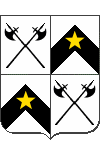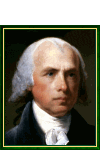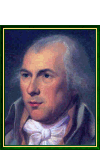President of the United States of America from 1809 to 1817

James Madison was born on March 16, 1751 in Port Conway, King George County, Virginia. He was the oldest of 12 children, though two died during childhood. His father owned a tobacco plantation.
He earned his degree in 1771 from the College of New Jersey (now Princeton University) after distinguishing himself academically and entered politics. During the Philadelphia Convention held from May to September 1787 headed by George Washington, Madison became the most active delegate, speaking more than 200 times and influencing the result to such an extent that he is now seen as the "Father of the Constitution".
He was elected to the Virginia House of Delegates in March 1789 and again in March 1793. He was also the author of the first ten Amendments pertaining to civil rights, known as the "Bill of Rights".
He was a member of the Republican Party (referred to by historians as the Democratic-Republican Party to avoid confusion with today's Republican Party) founded by Thomas Jefferson in 1792. When Jefferson was elected President in 1801, Madison became Secretary of State. In this role, he supervised the Louisiana Purchase from France that effectively doubled the size of the country. He showed less foresight in his support for the Embargo Act of 1807, the American response to the Franco-British conflict, which imperiled the country's economy.
As Jefferson's popular protégé and successor, James Madison was easily elected fourth President of the United States of America in 1809 when he ran against the Federalist Charles Coteworth Pinckney. He was re-elected four years later over DeWitt Clinton.
During his first term, Madison was confronted with a delicate international climate. In October 1809, he annexed the west part of the State of Florida where the colonists were rebelling against Spanish authority. However, the conflict between the United Kingdom and the French Empire preoccupied him the most. In February 1811, he banned trade with England. In 1812, he approached both antagonists with the same offer of an alliance against the other party to protect American ships from being boarded. Napoleon I accepted the offer first and Madison, under pressure from Congress, declared war on the United Kingdom on June 18, 1812.
In this war the British won one victory after another and even temporarily occupied Washington D.C. in August 14 forcing President Madison to flee the capital. Before leaving, the British took revenge for the destruction the year before of York, the capital of Upper Canada now called Toronto, by burning the American capital to the ground. The British also armed the Indian tribes in the West, in particular the Shawnee.
However, neither side saw any advantage in continuing the conflict: the English wished to concentrate their efforts on the war in Europe against Napoleon as part of the Sixth Coalition and the Americans wished to placate several states around New England had threatened to secede if the war continued. As a result, a peace treaty with England was signed in Gand on December 24, 1814 and ratified by James Madison on April 17, 1815.
After his second term in office, Madison left politics and devoted himself to his Montpelier property, near Orange in Virginia. He died there on June 28, 1836.
"James Madison", by John Vanderlyn (Kingston, New York 1775 - Kingston 1852).

The name Madison has been given, among many others, to an avenue and a square in New York City.
Acknowledgements
Other portraits

Enlarge
"James Madison", by Gilbert Stuart (Saunderstown, Rhode Island 1755 - Boston, Massachusetts 1828).

Enlarge
"James Madison" painted in 1792 by Charles Willson Peale (Chester, Maryland 1741 - Philadelphia, Pennsylvania 1827).